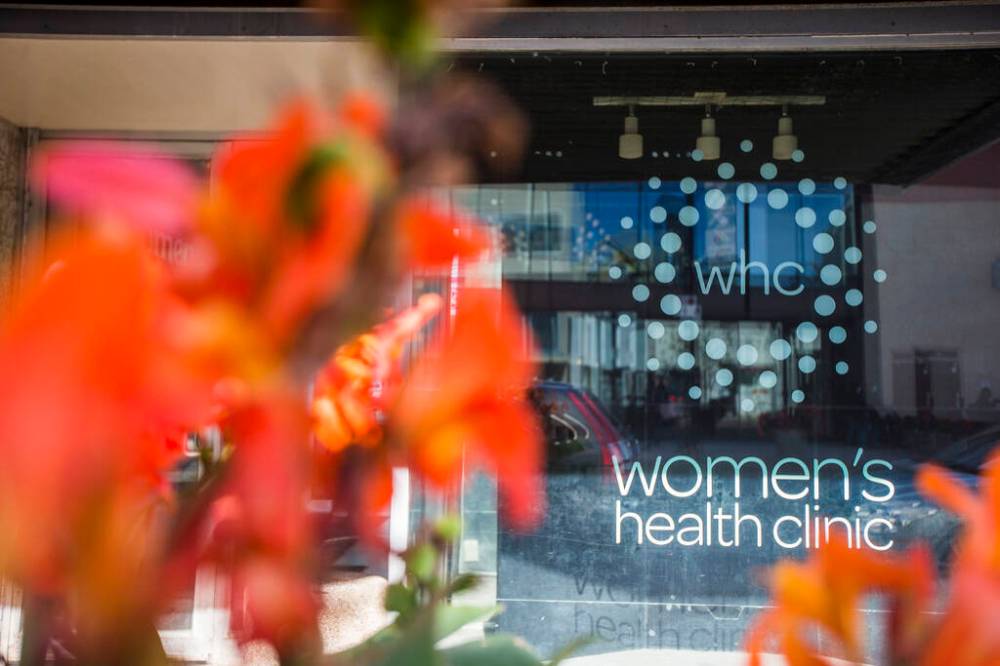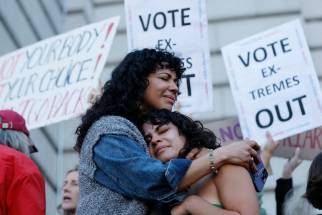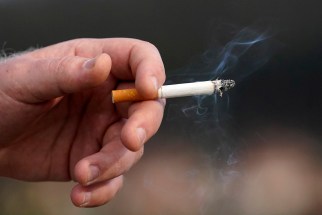Can you hear them? The women come from all segments of society, with reasons as equally diverse, but it’s critical their stories on why they chose an abortion are heard
Read this article for free:
or
Already have an account? Log in here »
To continue reading, please subscribe:
Monthly Digital Subscription
$0 for the first 4 weeks*
- Enjoy unlimited reading on winnipegfreepress.com
- Read the E-Edition, our digital replica newspaper
- Access News Break, our award-winning app
- Play interactive puzzles
*No charge for 4 weeks then price increases to the regular rate of $19.00 plus GST every four weeks. Offer available to new and qualified returning subscribers only. Cancel any time.
Monthly Digital Subscription
$4.75/week*
- Enjoy unlimited reading on winnipegfreepress.com
- Read the E-Edition, our digital replica newspaper
- Access News Break, our award-winning app
- Play interactive puzzles
*Billed as $19 plus GST every four weeks. Cancel any time.
To continue reading, please subscribe:
Add Free Press access to your Brandon Sun subscription for only an additional
$1 for the first 4 weeks*
*Your next subscription payment will increase by $1.00 and you will be charged $16.99 plus GST for four weeks. After four weeks, your payment will increase to $23.99 plus GST every four weeks.
Read unlimited articles for free today:
or
Already have an account? Log in here »
Hey there, time traveller!
This article was published 30/06/2022 (1263 days ago), so information in it may no longer be current.
Three days after the United States Supreme Court decision that toppled Roe v. Wade and paved the way for the end of safe, legal abortion in a swath of American states, an evangelical pastor, once one of the stars of the anti-abortion movement, went on CNN and told the story, again, of how he’d come to have a change of heart.
A few years ago, that pastor, Rob Schenck, had written on the same topic in the New York Times, where he acknowledged his former allies would consider him a “turncoat” for abandoning his fight to end Roe v. Wade. Once, he’d organized some of the most aggressive anti-abortion protests in the U.S., raised millions of dollars, and been arrested for his actions.
But over the last decade, the pastor wrote, he’d changed his view. He no longer believed that ending legal abortion would be, in his words, “pro-life.” He’d begun that transformation while he himself was incarcerated for anti-abortion activism, and in prison came into contact with people who had come from far more difficult circumstances than himself.
So to the audience of the Times and CNN, he spoke about how coming face-to-face with true poverty, with the fragility of life on the fringes, and with the appalling lack of social support for poor women and children had changed him. In that experience, he’d realized some situations are so difficult that those realities must be addressed, above all.
“Suddenly I realized the world is not the fantasy I imagined it to be,” he told CNN.
After that, he wrote in the Times, he’d come to believe that extreme anti-abortion laws “will leave poor women desperate and the children they bear bereft of what they need to flourish.” He’d come to doubt the ability and willingness of his movement to invest the same cash and energy in building the vast social supports necessary to make those lives bearable.

It was, I thought, both hopeful and frustrating to hear the story of his change of heart. Hopeful, because it suggests there is still a place the sides can meet, should they truly be motivated by love and compassion; frustrating, because prison couldn’t have been the first place Schenck encountered the fact that life, real life, is messy and painful and complicated.
Schenck must have heard the truth, long before. He must have read then, as there are plenty of places to read now, people testifying why they chose to end their pregnancies, about the infinite and always deeply personal reasons that inform each decision, reasons that have been with us for as long as we have borne children. He must have heard.
It wasn’t enough for him to hear, that’s what’s so frustrating. He heard, but never believed. For that, he had to see.
● ● ●
To this day, I remember word-for-word the little spiel I gave when I first sat down with each client. It’s been more than 10 years since the last time I said it, and yet it still holds the same weight to me now, that it did then. “Welcome to Women’s Health Clinic,” the preamble began. “We’re a feminist reproductive and sexual health clinic.
“What that means to us is that we think women are smart enough, and capable enough, to make decisions about their own lives,” I’d continue. “You know your life better than anyone else. Our job is to help you get the information and support you need to make the decisions that are right for you.”
My volunteer work there was pretty simple: I sat with women who were pregnant. I talked with them. I made sure they had all the facts they might need about abortion, or adoption, or all the supports that are available to parent a child and how to access them. I held space for them to cry, or talk about their lives, or just ask to schedule their appointment.
Over the years, I have made much of my life public. I lean on it the way many writers do, as a way to find the universal in the personal, or just to explore the texture of the world in a grain that can be felt finest through living it. But I never wrote about my time at WHC, because to me, it was sacred. It was the most transformative experience of my life, and it was private.
Maybe it’s time to write about it now. Only a little.

When I tell people about my two years volunteering at WHC, this is what I tell them: more than anything else in my life, that experience made me a better reporter and a better person. It taught me how to be present, how to meet people where they’re at, how to listen without judgment. Above all, it taught me how to really and deeply love women.
I don’t remember every client I had. I wouldn’t share their stories in any detail if I did. But I do remember the women.
The women: they fit every description. They were single, married, widowed, divorced. They were students and professionals and mothers. They were abuse survivors. They’d grown up in foster care. They’d grown up in war. They’d grown up and lived in every way that people can experience the world, which is to say real and imperfect and uniquely their own.
The youngest clients sometimes came with their friends, so anxious they would stare at their hands and twist their fingers as we spoke. The oldest client I ever had thought she’d hit menopause, because she hadn’t gotten her period for ages. When she went to a doctor about odd symptoms she was having, she learned, to her shock, that she was eight weeks pregnant.
They were all doing their best. That’s all I can say about the wide range of circumstances that informed my clients’ decisions. They were all doing the best they could with what they had been given. And the more I saw that, the more I knew that what I told them at the beginning was true: they were smart enough and strong enough to find their own way through.
Sometimes, leaving a session, I would think: if only the people who want to take this choice from them could see. If only they could be in this room, and listen, and understand a little better the reasons that bring people to the moment of making these decisions. But I would never have wanted to put that role on my clients. I would never wish that upon them.
I loved them all, very much. I can say that part too.
● ● ●
I remember the women.
I remember 31-year-old Savita Halappanavar, a dentist from Ireland, who died in 2012 when she was 17 weeks pregnant. She had gone to hospital suffering a stalled miscarriage, caused by a uterine infection. She’d asked multiple times for an abortion to complete the process; doctors, apparently not realizing her life was sufficiently at risk to allow the procedure, refused.
Halappanavar died of sepsis after seven days in hospital. One of the last things she ever heard was a midwife telling her “we don’t do that here dear, it’s a Catholic thing.” Her death galvanized the Irish public, and in 2018 a referendum to expand the legal accessibility of abortion in Ireland passed with resounding support. It didn’t bring Halappanavar back to her family.

I remember Elizabeth from Argentina, who died of septic shock in 2018 after desperately trying to end her pregnancy in a country where it’s illegal. I remember Izabela, from Poland, who died last year in similar circumstances to Halappanavar, after doctors refused to hasten a stalled miscarriage under the country’s restrictive anti-abortion laws.
“For now, thanks to the abortion law, I have to lie down,” she wrote in a text message to her mother. “And there is nothing they can do. They’ll wait until it dies or something begins, and if not, I can expect sepsis.”
And I remember the women all over the world, countless women who have died because doctors refuse to give them cancer treatment while they’re pregnant or let ectopic pregnancies burst. The women who die by suicide seeing no other hope. The women who die from unsafe abortions, which account for up to 13 per cent of global maternal deaths every year.
Advocates tell their stories. Some opponents either don’t care, or don’t believe. But soon, too soon, they will see.
melissa.martin@freepress.mb.ca
Our newsroom depends on a growing audience of readers to power our journalism. If you are not a paid reader, please consider becoming a subscriber.
Our newsroom depends on its audience of readers to power our journalism. Thank you for your support.












